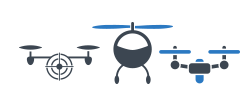The System
ResponDrone will develop and validate an integrated solution for first responders to easily operate a fleet of drones with multiple synchronized missions in order to enhance their situation assessment capacity and own protection. This System of Systems will simplify and accelerate situation assessment and information sharing, decision making and operations management, while requiring a small crew to operate it.
The ResponDrone system has the following advantages:

The smart planning tools will allow a single drone team to operate multiple drones at the same time, improving significantly human resources efficiency.

Dynamically calculated flight trajectories for each drone provided by the Traffic & Mission Management (TMM) component will ensure safe UAV operations.

The ResponDrone system will be designed to fit seamlessly into emergency response operational processes currently in use by first responders.

When the responsibility for flight planning and operations monitoring is transferred from the pilot in the field into a centralized system, those pilots will require less specific training, and thereby the deployment of drones will be more efficient.

The UAVs used in ResponDrone will be capable of providing communication channels for serving first responders on the ground, allowing them to communicate between themselves and to relay data from and to the command centers or the cloud.

ResponDrone will use web-based cloud technology in order to gather, store and provide collected data to all stakeholders. Personalized access rights ensure user-orientated data distribution.
ResponDrone will develop and validate an integrated solution for first responders to easily operate a fleet of drones with multiple synchronized missions to enhance their situation assessment capacity and own protection. This System of Systems will simplify and accelerate situation assessment and sharing, decision making and operations management, while requiring a small crew to operate it.
Moreover, it will deliver high-level information to any involved control center through an intelligent web-based system that can be operated and accessed from a remote site as well as serving as on-demand airborne communications network to allow people on the ground to communicate with the command center in case of cellular coverage collapse.
The ResponDrone system will be designed to fit seamlessly into any current emergency response operational processes, currently in use by first responders.
The smart planning tools will allow single drone pilots to be able to operate entire units or even fleets of drones, unlike the current situation where each pilot is operating a single drone. As each drone is usually assigned to a specific task, operating in fleets will allow operating in greater versatility and agility, in which several drones – each with its specific task as required by the situation – are operated simultaneously by a single control station. Moreover, when the responsibility for flight planning and operations monitoring is transferred from the pilot in the field into a centralized system, those pilots will require less specific training, and thus creating further efficiencies.
The airborne communications network will enable the agile establishment, extension, and reinforcement of communications in disaster scenarios for first responders. A fleet of drones operating as flying communications relays will provide the on-demand network infrastructure. The ResponDrone drones will be capable of forming cells for serving first responders on the ground and communicate between themselves to relay data from the cloud. The established network infrastructure will guarantee first responders can access the cloud-based mission’s command and control system by using a reliable communications infrastructure.
